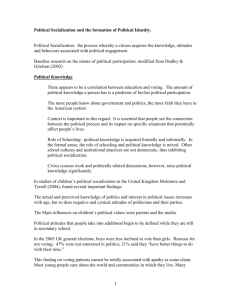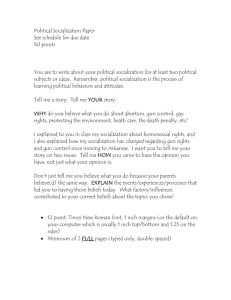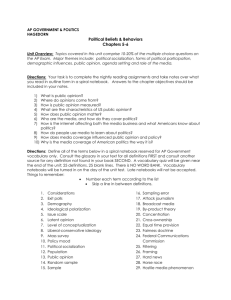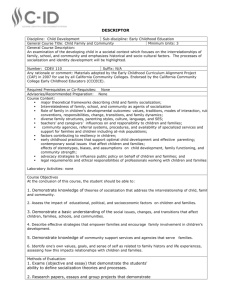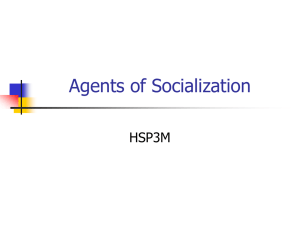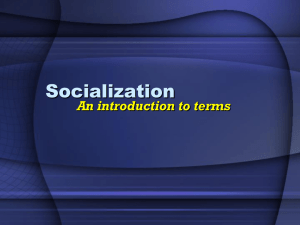Chapter 1: Issues in Comparative Politics
advertisement
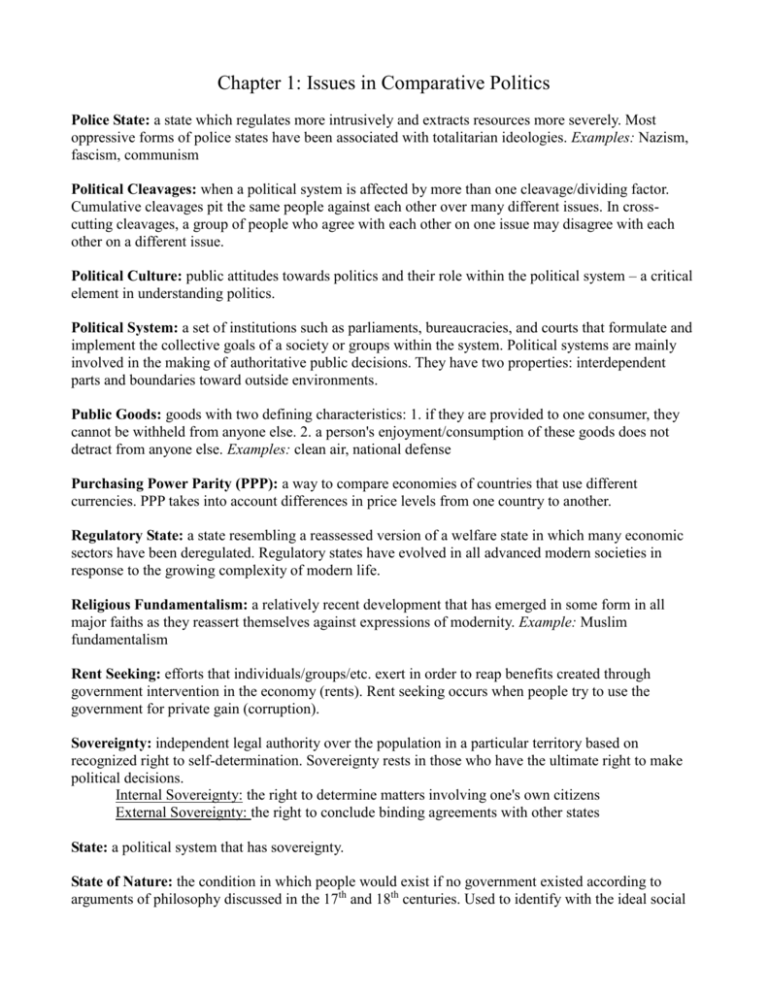
Chapter 1: Issues in Comparative Politics Police State: a state which regulates more intrusively and extracts resources more severely. Most oppressive forms of police states have been associated with totalitarian ideologies. Examples: Nazism, fascism, communism Political Cleavages: when a political system is affected by more than one cleavage/dividing factor. Cumulative cleavages pit the same people against each other over many different issues. In crosscutting cleavages, a group of people who agree with each other on one issue may disagree with each other on a different issue. Political Culture: public attitudes towards politics and their role within the political system – a critical element in understanding politics. Political System: a set of institutions such as parliaments, bureaucracies, and courts that formulate and implement the collective goals of a society or groups within the system. Political systems are mainly involved in the making of authoritative public decisions. They have two properties: interdependent parts and boundaries toward outside environments. Public Goods: goods with two defining characteristics: 1. if they are provided to one consumer, they cannot be withheld from anyone else. 2. a person's enjoyment/consumption of these goods does not detract from anyone else. Examples: clean air, national defense Purchasing Power Parity (PPP): a way to compare economies of countries that use different currencies. PPP takes into account differences in price levels from one country to another. Regulatory State: a state resembling a reassessed version of a welfare state in which many economic sectors have been deregulated. Regulatory states have evolved in all advanced modern societies in response to the growing complexity of modern life. Religious Fundamentalism: a relatively recent development that has emerged in some form in all major faiths as they reassert themselves against expressions of modernity. Example: Muslim fundamentalism Rent Seeking: efforts that individuals/groups/etc. exert in order to reap benefits created through government intervention in the economy (rents). Rent seeking occurs when people try to use the government for private gain (corruption). Sovereignty: independent legal authority over the population in a particular territory based on recognized right to self-determination. Sovereignty rests in those who have the ultimate right to make political decisions. Internal Sovereignty: the right to determine matters involving one's own citizens External Sovereignty: the right to conclude binding agreements with other states State: a political system that has sovereignty. State of Nature: the condition in which people would exist if no government existed according to arguments of philosophy discussed in the 17th and 18th centuries. Used to identify with the ideal social contracts on which societies are built. Totalitarian Systems: nations where governments restrict the rights and privacy of their citizens in a severe and intrusive manner. All totalitarian systems are authoritarian, but most authoritarian systems are not totalitarian. Examples: Nazi Germany, the Soviet Union United Nations (UN): an organization formed at the end of WWII that encompasses almost all of the world's states and supposedly has authority over world security and constraining, supporting, and replacing the unilateral actions of welfare states. Welfare State: engages in distributive activities to provide for health, education, employment, housing, and income support of its citizens; for this reason, it taxes more heavily. Welfare states are found in prosperous and democratic societies and originated in Germany. Anarchists: communitarians; people who see societies as close-knit, egalitarian communities and are of the opinion that governments and power corrupt such communities. Anarchists see an alternative in voluntary cooperation and natural communities. Example: Somalia's current political status practically leaves the country to be carved up by factions and war lords, creating anarchy. Civil Liberties: freedoms that protect the individual from government and set limits for the government so that it cannot abuse its power and interfere with the lives of its citizens. Basic civil liberties include freedom of speech, religion, etc. Example: the Bill of Rights details and guarantees various civil liberties. Democracy: “government by the people”; a political system in which citizens enjoy basic civil and political rights and in which most important political leaders are elected in “free and fair” elections which are accountable by law. Example: Sweden Democratization: movements in history towards democracy. Example: After WWI and WWII, there were movements towards democracy, the most recent being in 1974, involving Southern Europe, East Asia, Latin America, Eastern Europe, a number of African states, and the successor satellite states of the Soviet Union. Ethnicity: those human groups that entertain a subjective belief in their common descent because of similarities in physical type and/or customs, or because of memories of colonization and migration. There are five sets of traits which contribute to ethnicity: physical similarities, language, norms against intermarriage, religion, and negative historical memories. Example: the Tutsi vs. Hutu Genocide in Rwanda European Union: an organization composed of the majority of countries in the European continent. The EU is an example of the supranational organizations that are replacing the unilateral actions of states. Externalities: a type of market failure that occurs when some economic activity has costs that were not accounted for. Examples: pollution from factories, waste dumps, prisons, etc. Specifically: Chernobyl Governments: organizations of individuals who are legally empowered to make biding decisions on behalf of a specific community. Governments execute authoritative and coercive control. Example: United Russia Gross National Product (GNP): total economic output per person. Example: Russia's GNP is 7700 per capita Income and Wealth Inequality: uneven distribution of wealth – in one country, one region may suffer from poverty and hopelessness while other parts experience growth and improved welfare. Politics may be affected by division of wealth. Example: China's citizens' current economic situation greatly varies from the urban to the regional areas, which creates cleavages in China's politics. Libertarians: individuals who believe that society is made up of individuals with fundamental rights which need protection; unfettered individuals, free to make their own choices and join the groups they choose, who want property rights, freedom of speech, and protection of associations; people who believe that the main problem with the government is that the more it takes on, the more prone it is to violate basic rights. Example: Vladimir Putin's political opposition (and many Russians) criticize Putin's efforts to centralize the government, as they view their government as corrupt and inefficient. Nation: a group of people with a common identity; self-identification of a people. Nations do not necessarily have their own state or independent government. Example: Cataluna Nation-states: when national identification and the scopes of legal authority largely coincide. Example: Spain Night Watchman State Model: governments that provide basic law and order, defence, and protection of property, but little else (such as education). Examples: Most western countries, such as Spain, France, and Germany, are built upon the Night Watchman model. Oligarchy: “rule by the few”; a government ruled by a small group of people in which important political rights are withheld from the majority of people. Example: the communist elite of the USSR were oligarchs. Chapter 2: Comparing Political Systems Constitutional Regimes: can be compared with tyrannies in order to explain differences between the processes and performance of political systems. Example: Russia Communication: due to communication and interdependent economies, problems and achievements spill across national boundaries. Examples: Television, Internet, Radio, etc. Large “n” studies (Statistical studies): have a sufficient number and variety of cases to enable the researcher to examine the relationships between the variables (which are the dimensions or the parameters on which the cases differ.) Example: From government – democracy or dictatorship/income per capita; compare pre- and post-revolutionary countries. Small “n” studies (Case studies): permit investigators to go deeply into a case, identify the particularities of it, get the clinical details, and examine each link in the casual process. Examples: Why do democratic leaders behave in the way that they do? Why do democratic coumtries tend to be associated with wealth? System: suggests an object has moving parts, interaction with a setting or an environment. Example: Democracy Inputs: the political system receives inputs from domestic and international environment and attempts to shape them through its outputs. Example: Education and domestic economy Interdependence: when one political system is dependent on another political system and they are both affected by each other. Example: US and China. Structure: special agencies that help the government to perform its functions. There are six types of political structures: political parties, interest groups, legislatures, executives, bureaucracy, and courts. Example: Parliament. Process functions: include interest articulation, interest aggregation, policymaking and policy implementation and adjudication. Interest aggregation: demands expressed by the citizens are aggregated, or combined into policy alternatives (see Chapter 5). Policy implementation: enforcing policy. Policy adjudication: compromising policy if it is challenged or violated. System functions: socialization, recruitment and communication – they determine whether or not the system will be maintained or changed. Political socialization: how individuals form their political attitudes, and thus, collectively, how citizens form their political culture. Involves families, schools, communications media, churches, and all the various political structures that develop, reinforce and transform attitudes of political significance in the society. Direct political socialization: when political socialization involves the explicit communication of information, values, or feelings toward politics. Example: Civics courses in schools, religious indoctrination by fundamentalists, etc. Indirect political socialization: when political views are inadvertently molded by our experiences. Example: A child’s relationship to parents or teachers may affect the future adult’s response to authority Unifying political socialization: affects nearly the entire nation similarly and promotes national unity. Example: International conflict Divisive political socialization: can lead to civil strife or social hostility within a nation. Occurs when subcultures of a nation provide their members with their own distinctive pattern of socialization. Agents of political socialization: institutions and organizations that influence political attitudes. They may involve either direct or indirect socialization. Types of agents of political socialization: the Family, Schools, Religious Institutions, Peer Groups, Social Class, Gender, Mass Media, Interest Groups, Political Parties, Direct Contact with Governmental Structure Political recruitment: the selection of people for political activity and government offices. Political communication: refers to the flow of information through the society and through the various structures that make up the political system. Outputs: the implementations of the political process. Policy functions: the substantive impacts on the society, the economy, and the culture. Policy functions include regulation of behavior, extractions of resources (taxes) and distribution of benefits and services. Regulation of human behavior, distribution, extraction of resources – see Chapter 7. Outcomes: the results of political activities which result in new inputs (see Chapter 7). Political regime: the structural-functional-policy configuration governments take on at different times. Government efforts: what the government does vs. the actual outcome of the efforts Performance: outputs of a political system. Political “goods”: areas upon which people may value the performance of governments (see Chapter 7). Chapter 3: Political Culture and Socialization Political Culture: public attitudes toward politics and their role within the political system. Political Socialization: see Chapter 2 Legitimacy: determines whether citizens believe that they ought to obey laws or see no reason to obey laws. Legitimacy is the foundation for successful political process. Participants: citizens who are actual or potential participants in the political process. Subjects: citizens who passively obey government officials and law but do not vote or actively involve themselves in politics. Parochials: citizens who are hardly aware of government and politics. May be illiterates, rural people living in remote areas, or simply people who ignore politics and its impact on their lives. Consensual Political Culture: when citizens tend to agree on the appropriate means of making political decisions and to agree on the major problems facing the society and how to solve them. Conflictual Political Culture: when citizens are sharply divided, often on both the legitimacy of the regime and solutions to major problems. Political Subcultures: occurs when a country is deeply divided politically. The citizens may have sharply different points of view on at least some critical political matters, such as boundaries of nations, or the nature of the regime. Subcultural groups: cultural groups that form a minority of a population. Their culture is not spread nationwide. Fundamentalism: radical, literal interpretations of any religion that are often a defensive reaction against the new scientific and libertarian values. Many fundamentalists seek to raise conservative social, moral, and religious issues to the top of the contemporary policy agenda. Modernization: the secularizing influences of science that have encouraged citizen participation, a sense of individual equality, the desire for a better quality of life and government legitimacy based on policy performance. It has often disrupted familiar ways of life, traditional sources of legitimacy and political arrangements that depend on citizens remaining predominantly parochials or subjects. Postmaterial values: social equality, environmental protection, cultural pluralism, and self-expression. Ethnicity/Ethnic Groups: those human groups that entertain a subjective belief in their common descent because of similarities of physical type or of customs or both, or because of memories of colonization and migration, regardless of whether or not an objective blood relationship exists. Democratization: the trend toward a democracy. One broad, essential requirement for democracy is a free, regular, and fair competitive election. Marketization: a state’s re-creation of a market in which the concept of free markets and private profit incentives prevail rather than that of a government-managed economy. Example: Thatcherite policies in Britain Chapter 4: Interest Articulation Interest Articulation: citizens and social groups expressing (articulating) their needs and demands (interests) to the government. Personal Interest Contacts: personal contacts such as family or legislators that people use to articulate their interests through. Protests: spontaneous gathering of people outraged by the same things – direct action to articulate their interests. Anomic Groups: generally spontaneous interest groups that form suddenly when many individuals respond similarly to frustration. Nonassociational Groups: rarely well organized interest groups with episodic activity. Based on common interests and identities of ethnicity, religion, occupation or kinship. Collective Action Problems: members of interest groups often don’t want to commit the time and don’t want free riders to get credit. Institutional Groups: formal interest groups that have other political or social functions in addition to interest articulation. (ex. Roman Catholic Church) Associational Groups: formed explicitly to represent the interests of a particular group. They are influential in the policy process and are often recognized as legitimate in society. Civil Society: nongovernmental, voluntary society of organizations. People with common interests form groups. Pluralist Interest Group Systems: characterized by several features that involve both how interests are organized and how they participate in the political process . i. Multiple groups may represent a single societal interest ii. Group membership is voluntary and limited iii. Groups often have a loose or decentralized organizational structure iv. There is a clear separation between interest groups and the government Democratic Corporatist Interest Group Systems: characterized by a much more organized representation of interests . i. A single peak association normally represents each societal interest ii. Membership in the peak association is often compulsory and nearly universal iii. Peak associations are centrally organized and direct the actions of their members iv. Groups are often systematically involved in making and implementing policy Controlled Interest Group Systems: i. There is a single group for each social sector ii. Membership is often compulsory iii. Each group is normally hierarchically organized iv. Groups are controlled by the government or its agents in order to mobilize support for government policy (the most important one) Channels of Political Process: process by which interest groups reach key policymakers: a. legitimate/constitutional channels of political process: (mass media, parties, and legislatures) established by the legitimate structures of the gov, which designate the resources to be used in policymaking b. illegitimate, coercive access channels: direct action, for individuals and groups who feel that they are otherwise ineffective Political Terror Tactics: deliberate assassination, armed attacks on other groups or government officials, and provocation of bloodshed. Chapter 5: Interest Aggregation and Political Parties Interest Aggregation: the activity in which the political demands of individuals and groups are combined into policy programs. Example: a farmer's desires for higher crop prices. A specific program becomes politically significan when it is backed up by substantial political resources. Examples: popular vote, media access The nature of the aggregation process inevitably has major implications for which interests are heard, and what individuals and groups are allowed to participate in the process. It helps create a balanced government program, as competing policy goals must be comprised to produce a single governing program. The pattern of interest aggregation is linked to the stability of governments and their ability to function and adapt. Interest aggregation can occur in many ways: if an influential party leader or military dictator controls substantial political resources, his/her personal impact on interest aggregation may be considerable. In the same manner, nations usually develop more specialized organizations (political parties) for aggregating interests and resources behind a policy. Political parties are important interest aggregators in both democratic and nondemocratic systems. In a democratic system, two or more parties compete to gain support for their alternative policy programs. In authoritarian systems a single party or institution may try to mobilize citizens’ support for its policies. In both systems interest aggregation may take place within a political party. Example: party leaders hear the demands of different groups (unions, party factions, etc.) and create policy alternatives. In authoritarian systems the process is controlled, and interests are often mobilized to support the government, rather than the government responding to public interest. Patron-Client Network: a structure in which a central officeholder, authority figure, or group provides benefits to supporters in exchange for their loyalty. Associational Groups: groups that operate to express demands and support political contenders such as political parties. Note that associational groups can occasionally wield sufficient resources to become contenders in their own right. Example: the Labour Party historically rested on the unions’ ability to develop coherent policy positions and mobilize the votes of their members (who were formally represented in the party) to support those positions. Institutional Groups: important interest aggregators given that they are formal groups (political parties, military, bureaucracy, church) that represent interests. They have other political or social functions in addition to interest articulation. Example: non-political institutional groups can also become involved in political processes, like the Roman Catholic Church, businesses, etc. In authoritarian countries, the following all have significant roles in interest articulation: education officials, party officials, jurists, officers in military services, government bodies representing other social units Competitive Party Systems: primarily try to build electoral support. Authoritarian Party Systems: seek to direct society (also known as noncompetitive). Single-member District Plurality Election Rule: often called “first-past-the-post” given that in this system the winner need only finish ahead of the others but not win the majority of the votes. Proportional Representation: the country is divided into a few, large districts (or kept as a single national district). The competing parties offer lists of candidates, rather than a single candidate. The number of legislative representatives a party wins depends on the overall proportion of the votes it receives. Sometimes parties must achieve a minimum threshold of votes, usually 3-5%, to receive any seats at all. Majoritarian two-party systems: dominated by 2 parties or have 2 substantial parties and election laws that create legislative majorities for one of them. Examples: the United States or Britain Majority-coalition systems: systems where parties establish open pre-electoral coalitions so voters know which parties will attempt to work together to form a government. Example: Catalunya Multiparty systems: have combinations of parties, voter support, and election laws that ensure that no single party wins a legislative majority. Examples: Germany and France Consensual party system: the parties commanding most of the legislative seats are not too far apart on policies and have a reasonable amount of trust in each other and in the political system Examples: in the United States: Democrats and Republicans; in Norway and Sweden: socialists, center, liberals, conservatives, and small communist groups Conflictual party system: the legislature is dominated by parties that are far apart on issues or are reluctant toward each other and the political system. Example: Russia Accommodative party system: has mixed characteristics of a certain kind, both consensual and conflictual. Examples: Austria and Lebanon: after WWI, suspicious groups – socialists and Catholics in Austria, and the Christians and Muslims in Lebanon – worked out understandings to make stability possible. Exclusive governing party: insists on control over political recourses by the party leadership. It recognizes no legitimate interest aggregation by groups within the party nor does it allow any free activity by social groups, citizens, or other government agencies. Examples: Communist parties of the USSR (before 1985), of Eastern Europe (before 1989), of North Korea, Vietnam, and Cuba; China: CCP allows interest articulation by individuals, within bounds, while the mobilization of support before the elite has decided on policy is not permitted. Inclusive governing party: recognizes and attempts to coordinate various social groups in the society. It accepts and aggregates certain autonomous interests, while repressing others and forbidding any serious challenges to its own control. Examples: Africa- Kenya and Tanzania recognize the autonomy of social, cultural, and economic groups and try to incorporate them, rather than control and remake them; Mexico’s Institutional Revolutionary Party (PRI) was successful until its recent transition. Military governments: with its control of instruments of force, and in the absence of a strong constitutional tradition, the military was an effective contender for power. After WWII, parliamentary and democratic systems were put into place in most Third World countries; however, in many countries the lack of effectiveness and authority led to the replacement by military governments. Examples: Brazil (1964): the military played a crucial role in interest aggregation for the process towards democracy; Syria, Pakistan, Guinea, Zaire, Paraguay, and Haiti: the military has long been dominant, or, at least, a major interest aggregator.


